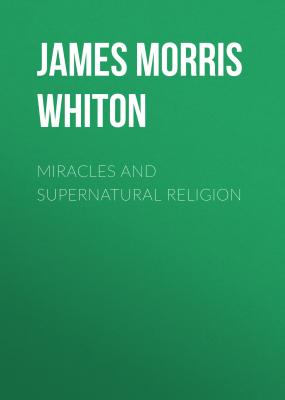ТОП просматриваемых книг сайта:















Miracles and Supernatural Religion. James Morris Whiton
Читать онлайн.Название Miracles and Supernatural Religion
Год выпуска 0
isbn
Автор произведения James Morris Whiton
Жанр Философия
Издательство Public Domain
3
For an earlier statement of this by the present writer, see a discourse on "Miracle and Life," in
4
5
6
1 Kings xiv. 1-7.
7
It is not intended to intimate that there is no such darker reality as a "possession" that is "demoniac" indeed. It cannot be reasonably pronounced superstitious to judge that there is some probability for that view. At any rate, it is certain that the problem is not to be settled by dogmatic pronouncement. It is certain, also, that the burden of proof rests on those who contend that there can be no such thing. On the other hand, it may be conceded that the cases recorded in the New Testament do not seem to be of an essentially devilish kind. On the general subject of "possession" see F. W. H. Myers's work on
8
See
9
Dr. Peloubet,
10
Dr. Lyman Abbott in
11
The Anglicized Latin word, "miracle," indiscriminately used in the Authorized Version, denotes the superficial character of the act or event it is applied to, as producing wonder or amazement in the beholders. The terms commonly employed in the New Testament (
12
An objection to the historicity of the raising of Lazarus which is made on the ground that so great a work, if historical, would have been related by more than one of the Evangelists, yields on reflection the possibility that Jesus may have effected more than the three raisings recorded of him. John is the sole narrator of the raising of Lazarus. But he omits notice of the two raisings recorded by the other Evangelists, while Matthew and Mark do not record the raising of the widow's son recorded by Luke. All this suggests that the record may have preserved for us specimens rather than a complete list of this class of miracles. (Compare John xxi. 25.)
13
"We have frequent cases of trance, … where the parties seem to die, but after a time the spirit returns, and life goes on as before. In all this there is no miracle. Why may not the resuscitations in Christ's time possibly have been similar cases? Is not this less improbable than that the natural order of the universe should have been set aside?"—
14
On account of the ceremonial "uncleanness" caused by the dead body. See Numbers v. 2, and many similar passages.
15
16
Other writers might be mentioned, as Mme. Necker (1790), Dr. Vigné (1841). Yet on the other hand it is alleged, that "none of the numerous stories of this dreadful accident which have obtained credence from time to time seem to be authentic" (

